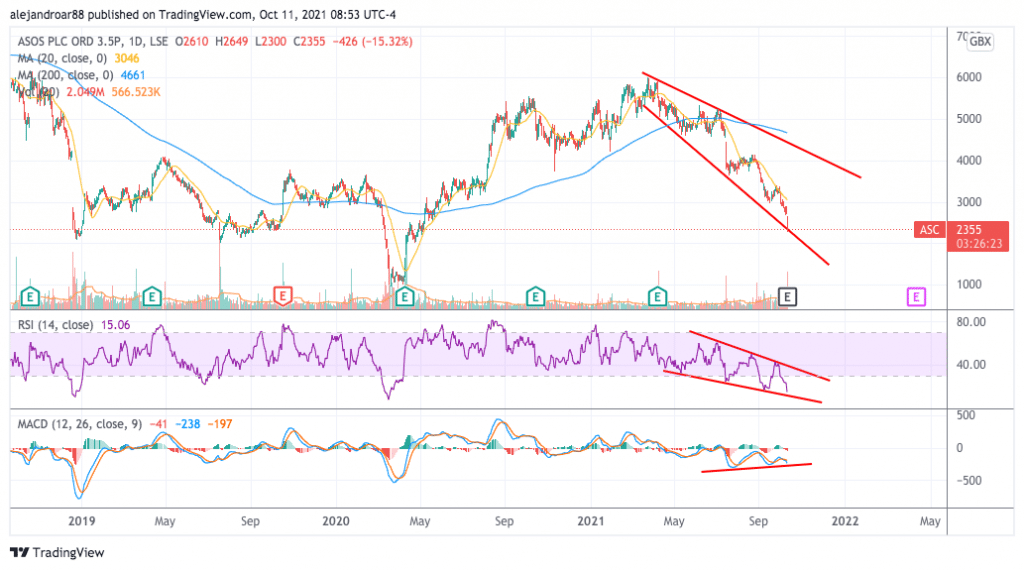Asos Shares Down 14% Today – Time to Buy Asos Shares?
Please note that we are not authorised to provide any investment advice. The content on this page is for information purposes only.
The price of Asos shares is plunging over 14% so far this morning in London after the company announced the departure of its Chief Executive Nick Beighton along with providing a downbeat earnings forecast for the full 2022 fiscal year.
According to a statement released this morning, Beighton’s step-down comes as part of the firm’s effort to enter “the next phase of its global growth strategy”. For the time being, Mat Dunn, Asos’s Chief Financial Officer, will oversee the day-to-day operations of the business until a successor is appointed.
The fact that there was no successor in place points to this decision as one that was not thoroughly planned and it seems to be interpreted as a sign of weakness in Asos business by market participants.
“Over the last three years we have made significant progress, delivering 60% growth in revenues, improved profitability and a strengthened balance sheet; we have bolstered the management team and improved ASOS’s operational capabilities and resilience”, stated Adam Crozier, the firm’s former Non-Executive Chairman of the Board whose departure was announced weeks ago.
He added: “At the same time, however, we recognise that there is more to do to accelerate the pace and intensity of commercial execution”.
The company also forecasted profit before taxes ranging from £110 million and £140 million for the full 2022 fiscal year. Such a figure would result in a 21% to 38% decline in Asos’s bottom-line profitability compared to the PBT of £177.1 million the firm reported for the fiscal year ended on 31 August 2021.
Asos’s management cited “notable cost headwinds” including supply-chain disruptions, labour cost inflation, and higher freight costs as some of the causes for this profit warning.
Considering the downbeat tone of this earnings release, what can be expected from Asos shares in the near future? In the following article, I’ll be analyzing the price action and fundamentals of the company to outline plausible scenarios for the future.
67% of all retail investor accounts lose money when trading CFDs with this provider.
Asos Shares – Technical Analysis

The downtrend that started back in March this year for Asos shares has now gone parabolic amid the sharp declines the stock price has suffered lately. Currently, ASC shares are trading more than 60% below their 52-week high of 5,995p per share while they are tagging the lower trend line shown in the chart above.
Interestingly, the stock is diving below its pre-pandemic levels as, even though the company took advantage of the tailwind provided by lockdown measures, the future doesn’t seem too bright as a result of the multiple headwinds cited by the management in this earnings release.
Today’s trading volumes show the extent of the selling pressure as they are exceeding the 10-day average by nearly 4 times while the Relative Strength Index (RSI) is on a severe downtrend – currently standing at 15. This has been the lowest reading posted by the oscillator since the pandemic crash.
That said, there is a glimpse of hope that the downtrend may have gone too far as the MACD has posted a series of higher lows despite the price dropping to lower levels. This slight bullish divergence could be a signal that a technical rebound could occur soon for Asos shares.
This view is reinforced by the fact that ASC shares are trading 49% below their 200-day moving average. Even though the firm’s profitability is suffering from these temporary headwinds, the extent of this sell-off shows that the market is perhaps overreacting to the news.
Asos Shares – Fundamental Analysis
Including last year’s results, Asos’s revenues have been growing at a compounded annual growth rate of 15.2% since 2016 while the company managed to push its top-line results 20% higher during the 2021 fiscal year amid the tailwind provided by the pandemic.
For this upcoming 2022 fiscal year, the management is expecting to grow the firm’s revenues by 10% to 15% – in line with its historical performance – but has warned that profit margins will suffer amid the multiple supply-side headwinds that the sector as a whole is experiencing.
In this regard, this forecasted £110 – £140 million range for Asos’s PBT would result in a PBT margin of 3.1% using the upper bound of the management’s estimates for both revenues and earnings. Last year, this margin was 4.5% while in 2020 it landed at around 4.4%.
Even though this profit warning is important, it seems that the market’s overly negative reaction is more associated with the departure of the company’s CEO and the fact that the transition may not be smooth since a replacement has not yet been found.
This could leave Asos wandering in the wilderness for a while at a point when the firm is struggling to navigate the complex waters of the current supply chain crisis. This could translate into further, and possibly beyond-expected, disappointing financial performance in the future and this seems to be the reason why today’s decline is so sharp.
At its current market capitalization of £2.4 billion, the firm is being valued at only 22 times its forecasted after-tax earnings assuming a 20% tax rate. This valuation metric seems conservative for a business that has such a strong brand positioning and loyal customer base.
However, it is usually a bad idea to try to catch a falling knife and that is exactly what Asos shares are at the moment. Therefore, until the price action finds a stronger floor, the outlook for the company remains bearish based on the overly pessimistic outlook that market participants have for the business amid the current leadership transition.






